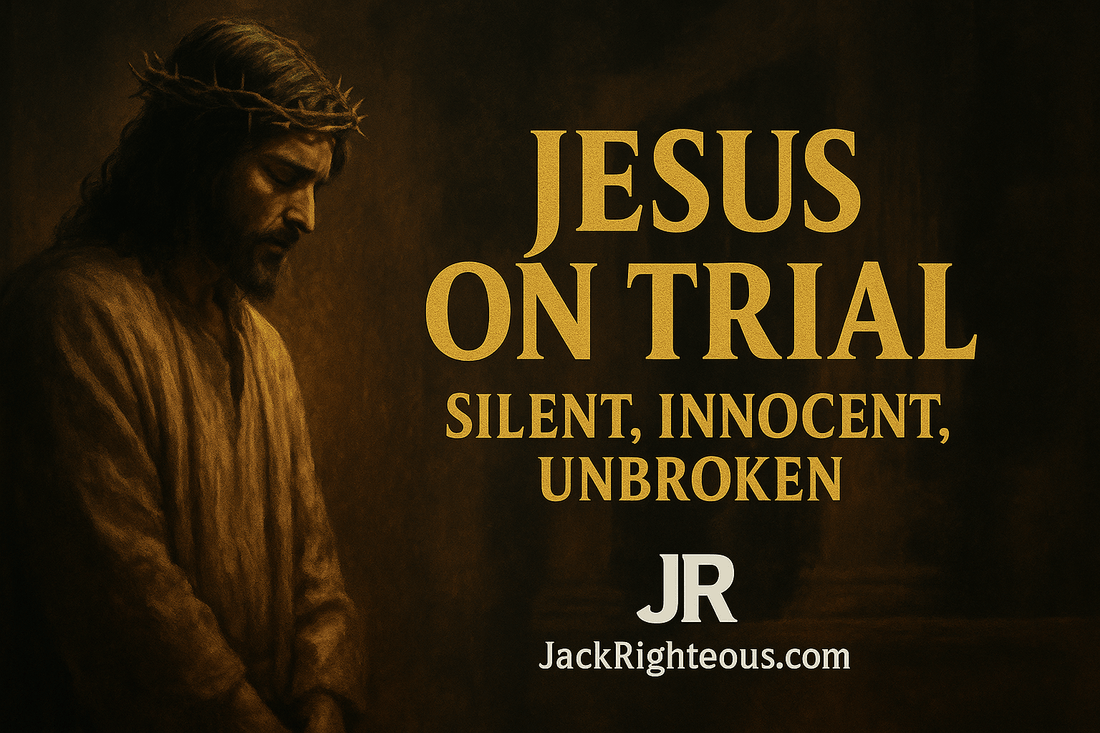
Jesus on Trial: Silent, Innocent, Unbroken
Gary WhittakerThe Innocent Who Stood Silent While Systems Collapsed
Man, Myth, Legend – Day 6 (Morning): Good Friday
🔹 The Man (What Actually Happened)
Jesus was arrested late Thursday night and dragged before multiple authorities from midnight into early Friday morning. Each system—religious, political, and cultural—was put on trial that night. But Jesus wasn’t the one on trial.
⚖️ The Jewish Trials
He was taken first to Annas, the former high priest, then to Caiaphas, the acting high priest, where the Sanhedrin had assembled under cover of darkness. These weren’t legitimate proceedings. They were:
- Held at night (against Jewish law)
- Based on false witnesses who contradicted each other
- Lacking any formal verdict until sunrise
Still, they pushed for a charge of blasphemy after Jesus affirmed:
“You will see the Son of Man seated at the right hand of Power…”
(Matthew 26:64)
They spit on Him, struck Him, and sent Him to Pilate, the Roman governor, for execution.
🏛️ The Roman Trials
Pilate found no basis for guilt and offered to release Jesus, but the crowd—manipulated by religious leaders—demanded Barabbas instead. Pilate tried to push responsibility to Herod, but Herod mocked Jesus and sent Him back.
Eventually, Pilate gave in:
“I am innocent of this man’s blood.”
“His blood be on us and on our children!” the crowd answered.
Jesus was flogged, mocked, crowned with thorns, and condemned. But through it all...
He didn’t defend Himself.
He stood silent as every system failed—justice, religion, public opinion, leadership.
Relevant disciple profiles:
🔹 The Myth (What People Get Wrong)
“Jesus was silent because He was afraid.”
Wrong. Jesus’ silence wasn’t weakness—it was sovereignty. He had already made His case. Now He let the broken systems collapse under their own weight. He was in control, even in silence.
“Pilate wanted to save Him.”
Pilate didn’t want a riot—not justice. His role in the story isn’t compassion. It’s cowardice. He symbolically washed his hands while literally condemning an innocent man.
“The Jewish people killed Jesus.”
No. Some religious leaders manipulated events. But this was a Roman execution using a Roman method under the authority of Roman power—with political motives. Blaming an entire people is not only wrong—it’s dangerous.
🔹 The Legend (Why It Still Matters)
This is where truth was tried by corruption—and still stood undefeated.
Jesus, fully innocent, allowed Himself to be condemned so the guilty could be freed.
He wasn’t outmaneuvered. He walked through each step with eyes wide open, laying down His life while exposing the rot in every system.
This moment holds a mirror to us: What systems do we trust that can’t bear real righteousness?
And when the pressure hits—do we stand silent, or stay true?
In the Jack Righteous Universe, this is the backbone: systems crumble, but truth doesn't.
👥 Community Note
What part of this trial scene hits hardest?
And if you’ve got a track—especially from Suno—that captures themes of justice, innocence, or systems breaking, drop it here.
Or explore the build-up with the full disciples series:
📖 Why the 12 Disciples Still Matter
Explore the Full Passion Week Series
Walk the final days of Jesus with clarity, depth, and purpose—one day at a time:
- 🕊️ The Humble King Who Rode a Righteous Ass and Made a City Choose
- 🔥 The Temple Flipper Who Exposed a Broken System
- 📣 The Last Prophet Standing in the Temple Courts
- 🕵🏽 The Spy Among Us and the Woman Who Saw It Coming
- 🧼 The Servant King Who Fed, Washed, and Wept
- ⚖️ The Innocent Who Stood Silent While Systems Collapsed
- ✝️ The Lamb Who Didn’t Come Down From the Cross
- ⚰️ The King Buried By Friends in a Borrowed Tomb
- 🌑 The Silence That Made Heaven Hold Its Breath
- 🌅 The Risen One Who Called Her by Name First
- 🔥 The Stranger Who Broke Bread and Set Hearts on Fire
- 👑 The Ascended One Who Left the Door Wide Open
➕ Want the bigger picture?
This article breaks down how it all fits together—and why the resurrection still disrupts, heals, and sends:
📖 Why the Resurrection Still Shakes the World
Ready to Launch or Level Up Your AI Music Journey?
🔹 Start Here – The Suno AI Creator Guide:
https://jackrighteous.com/pages/suno-guide-getting-started
🔹 Learn to Brand with Sound – GET JACKED Into Suno Branding:
https://jackrighteous.com/pages/start-ai-music-branding
🔹 Unlock the Full Anthem Path – GET RIGHTEOUS System Access:
https://jackrighteous.com/pages/get-righteous-anthem-guide
(Requires one of the following:
– https://jackrighteous.com/products/get-jacked-full-pro-kit
– https://jackrighteous.com/products/get-jacked-pro-ai-music-kit
– https://jackrighteous.com/products/sanctuary-digital-download-support-the-album-build)

